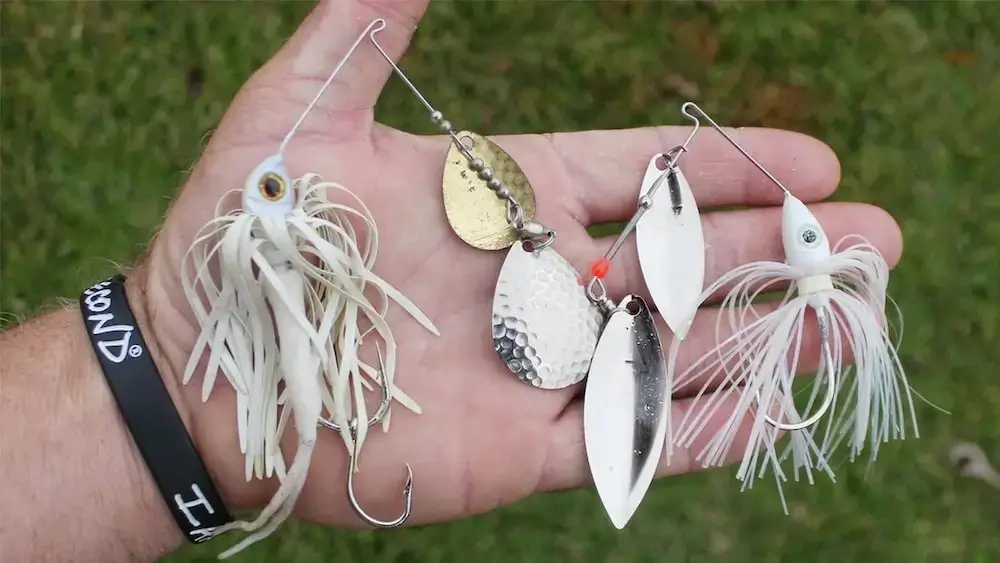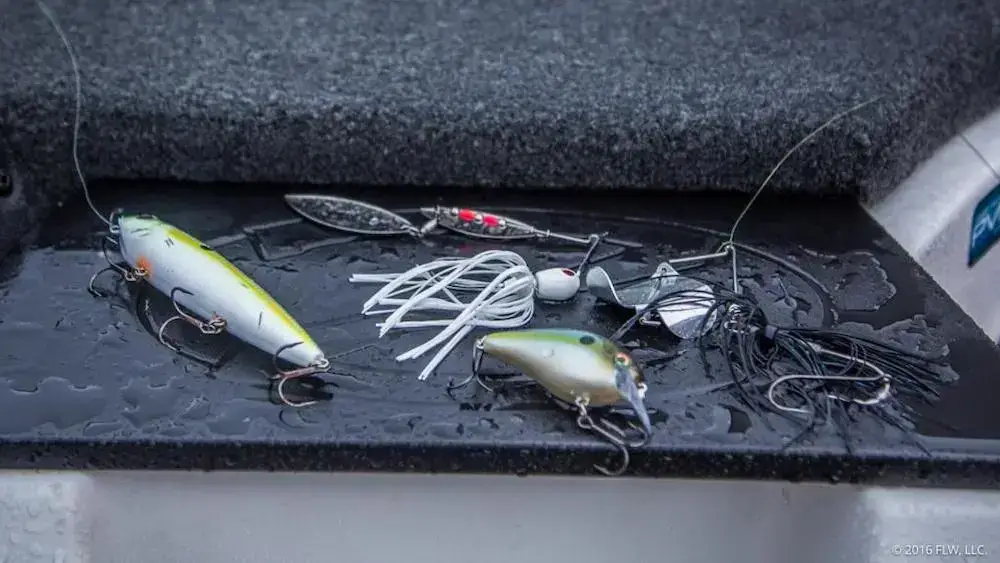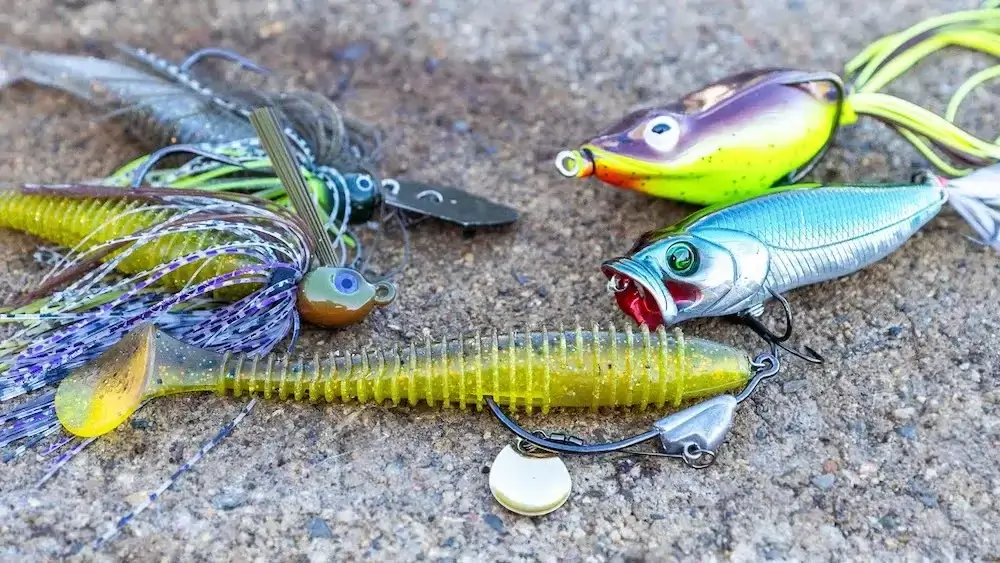Do you know what lures to use for bass after rain? Unfortunately, many fishermen are unsure of what to do when the weather turns bad. The good news is that there are many different lures that you can use to catch bass in wet conditions.
This blog post will discuss the best lures for bass after rain. We will also provide a comprehensive guide on using these lures effectively.
What Bass Like to Eat After a Rainstorm

Bass are opportunistic feeders, which means they will eat just about anything they can fit in their mouths. But bass prefers certain types of food, and these change depending on the time of year and the water conditions.
In general, after a rainstorm, bass will be looking for food that is high in protein and easy to digest. This could include minnows, crayfish, frogs, and insects.
The key is to look for areas where these food sources are likely to congregate, such as near logs, rocks, or other structures.
Of course, every bass is different, and there is no guarantee that they will all be after the same thing. So it’s important to experiment with different lures and bait until you find something that works.
What Lures to Use for Bass After Rain
After a rain, the water temperature can drop significantly. This is why it’s important to know what lures to use for bass after rain. Here is a comprehensive guide on selecting the best lures for bass fishing after rain.
The first thing you need to do is determine the water temperature. You can do this by using a thermometer or by feel.
If the water is cold, you’ll want to use a slow-moving lure such as a plastic worm. If the water is warmer, you can use a faster-moving lure such as a spinnerbait.
The next thing you need to consider is the type of cover in your fishing area. If there is a lot of vegetation, you’ll want to use a lure that can penetrate the cover, such as a jig. If there is less vegetation, you can use a topwater bait like a frog.
Finally, it would help if you considered the fish’s activity level. If the fish are active, you’ll want to use a lure that creates a lot of movement, such as a crankbait. If the fish are less active, you can use a slower-moving bait like a plastic worm.
Another thing you need to know is what kind of bass you’re fishing for. There are three main types of bass: largemouth, smallmouth, and spotted.
Each type of bass prefers different lures, so it’s important to know which one you’re going after.
- Largemouth bass are the most popular type of bass to fish for. They’re the biggest, and they put up a good fight. They’re also the easiest to catch, so if you’re new to bass fishing, this is the type you should start with.
- Smallmouth bass are a little harder to catch than largemouth, but they’re just as fun. They’re a bit smaller, but they make up for it with their feistiness.
- Spotted bass are the hardest to catch of the three, but they’re also the most rewarding. They’re the smallest of the three, but they fight the hardest.
Now that you know what kind of bass you’re after, it’s time to choose your lure. Unfortunately, there are a lot of different lures to choose from, and it can be overwhelming. But don’t worry, we’re here to help.
Here are some of the best lures to use for bass after rain:
- Jerk baits
- Crank baits
- Spinner baits
- Plugs
- Soft plastics
Each of these lures has its advantages and disadvantages, so it’s important to choose the right one for the situation. For example, jerk baits are great for fishing in murky water, while crank baits are better for clear water.
Spinner baits are good for all types of water, but they’re especially effective in stained water. Plugs are great for fishing in deep water, while soft plastics are better for shallow water.
The Best Times of Day to Go Fishing for Bass

The best time of day to fish for bass after rain is in the early morning or late evening. The sun will be less intense, and the water will be cooler, making the fish more active.
Bass are also more likely to feed during these times as they search for food before nightfall or after sunrise.
If you can’t make it out during the early morning or late evening, the next best time to fish for bass is during the middle of the day. Bass will be less active during this time, but they will still be feeding.
The worst time of day to fish for bass is in the afternoon when the sun is at its strongest. The heat will make the fish sluggish, making them less likely to bite.
No matter what time of day you go fishing for bass, always bring the proper lures. These fish are notoriously difficult to catch, so you’ll want to make sure you’re using the right bait. In the next section, we’ll go over some of the best lures for bass.
What Type of Gear You’ll Need for Successful Bass Fishing
If you’re new to bass fishing, the amount of gear and different types of tackle can be daunting. But don’t worry; we’ll help you sort out what you need to get started.
The most important gear for bass fishing is a good quality rod and reel combo. There are many different types and styles of rods and reels, but the most important thing is to get a combo that’s well-made and suited for the type of fishing you’ll be doing.
You’ll also need some basic tackle, like hooks, weights, and lines. Again, there are many different types and styles of tackle available but don’t get too caught up in all the options. Start with some basic tackles and then experiment as you get more experience.
Finally, you’ll need a few other items like a landing net, bait bucket, and pliers. These are all pretty self-explanatory but get good quality gear.
How to Keep Track of Your Catches and Improve Your Technique Over Time

One of the most important things you can do to improve your bass fishing after rain is to keep track of your catches.
This means noting not just what lures you used but also where and when you caught fish, what the water conditions were like, and anything else that might have influenced your results.
By keeping track of this information, you can start to see patterns emerge that will help you better understand what works and what doesn’t.
Of course, simply knowing what lures to use after a rainstorm isn’t enough – you also need to know how to fish them effectively. This is where practice comes in. The more you fish, the more experience you’ll gain, and your results will be better.
So, don’t be afraid to experiment after a rainstorm – it’s the perfect time to try out new techniques and lures and see what works best for you. With a little bit of effort, you’ll be able to take your bass fishing game to the next level.
Conclusion
The lure you use after rain can make a big difference in your success. If you know what to look for and are willing to experiment, you can catch bass even when the conditions aren’t ideal. So use these tips the next time you go fishing after a storm and see how successful you can be. Good luck.

